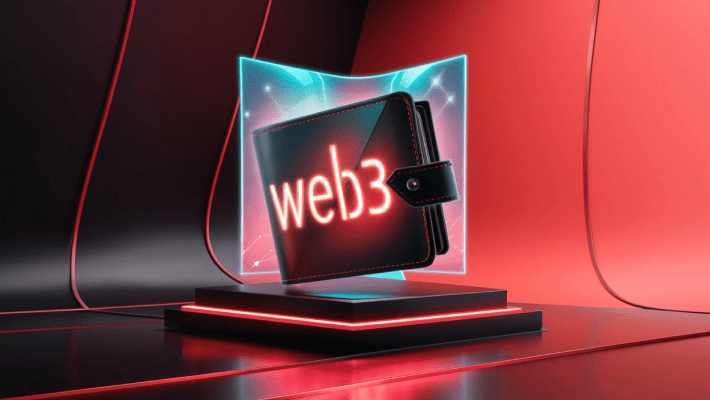How Does a Web3 Wallet Work? Key Functions For Founders
03 May 2024Defining Web3 Wallets
Web3 wallet development is the next stage in digital wallet technology. Web3 wallets are designed to interact seamlessly with decentralized applications (dApps) and blockchain networks. Web3 wallets serve as digital repositories for storing and transferring cryptocurrencies. Unlike traditional wallets, they operate on decentralized networks, enabling users to manage their crypto assets securely.
Web3 wallet development involves integrating advanced cryptographic principles and decentralized protocols. Blockchain technology ensures transparency, immutability, and security in every transaction and interaction.
Explore our recent article on How to Build Web3 Applications!
Importance of Wallets in the Web3 Ecosystem
In the Web3 ecosystem, where decentralization is key, Web3 wallets act as gateways for users to access and engage in decentralized finance (DeFi), non-fungible tokens (NFTs), decentralized autonomous organizations (DAOs), and more. They allow users to easily manage their digital assets and interact with various decentralized services directly from their wallets.
Moreover, Web3 wallets play a pivotal role in fostering financial inclusion by providing access to financial services for users across the world, regardless of geographical location or socioeconomic status. Through Web3 wallet development, developers are continuously innovating to enhance user experience, security, and interoperability, thereby driving the mass adoption of decentralized technologies.
Key Components of Web3 Wallets
The power of crypto wallet app development lies in the fundamental components of these wallets. Let’s explore key of them.
Public and Private Keys
The security foundation of web3 wallet development relies on a pair of cryptographic keys: the public key and the private key. These keys are essential for security, allowing users to securely access and control their digital assets. The public key serves as the user's wallet address, enabling others to send funds or interact with their wallet. Conversely, the private key acts as the secret passphrase, granting exclusive access to the wallet and authorizing transactions. Web3 wallet development ensures the confidentiality and integrity of users' assets through robust encryption algorithms, safeguarding against unauthorized access or tampering.
Wallet Addresses
In web3 wallet development, wallet addresses serve as unique identifiers for transactions. These addresses are derived from the public key and are used as destination points for sending and receiving cryptocurrencies or tokens. Web3 wallets use advanced hashing algorithms to generate wallet addresses that are impractical to replicate or reverse-engineer, enhancing security and privacy.
Blockchain Node
At the core of every Web3 wallet lies a blockchain node, which serves as the gateway to the decentralized network. The blockchain node communicates with other nodes to validate transactions, update the ledger, and synchronize with the latest blockchain state. It ensures that users have real-time access to the blockchain network and can interact with it securely.
Frontend & Backend Infrastructure
Web3 wallets feature a robust frontend and backend infrastructure that facilitates user interaction and data processing. The frontend interface provides users with a user-friendly dashboard where they can view their balances, initiate transactions, and interact with dApps. On the backend, sophisticated algorithms handle tasks such as transaction validation, encryption, and network communication, ensuring the smooth operation of the wallet.
Smart Contracts
Smart contracts play a pivotal role in Web3 wallet development, enabling advanced functionalities such as staking, swapping, and more. These self-executing contracts are programmed to automatically enforce the agreed terms when predefined conditions are met. In the context of Web3 wallets, smart contracts facilitate operations such as token swaps, liquidity provision, yield farming, and governance participation. They enhance the security, transparency, and efficiency of transactions within the wallet ecosystem.
How a Web3 Wallet Works
For businesses embarking on Web3 wallet development, a comprehensive understanding of the technical features and user interactions is essential. In this detailed guide, we explore the nuanced functionalities at each step of user interaction with a Web3 wallet, providing valuable insights for project owners aiming to develop robust and user-friendly web3 wallet solutions.
1. Setting Up a Web3 Wallet
Creating a Wallet: Users can create their Web3 wallet through a simple registration process. It is crucial to incorporate UX/UI features in web3 wallet development to ensure that even those unfamiliar with web3 and cryptocurrencies can easily create a wallet. Intuitive user interfaces should be implemented for account creation, capturing necessary user information, and securely generating cryptographic key pairs.
Backing Up a Private Key/Seed Phrase: To ensure data redundancy and recovery in case of wallet loss or device failure, users are prompted to back up their private keys or seed phrases. Web3 wallet developers integrate robust backup mechanisms, such as mnemonic phrases or encrypted backups, and guide users through the backup process to mitigate the risk of data loss.
2. Accessing a Web3 Wallet
Secure Authentication: Upon accessing their Web3 wallet, users are prompted to authenticate their identity using secure authentication mechanisms. Project owners implement PIN codes, passphrase authentication or other mechanisms to verify user identities securely and prevent unauthorized access to the wallet.
Wallet Recovery: In the event of a forgotten password or lost device, users can initiate the wallet recovery process to regain access to their funds. Web3 wallet developers deploy robust recovery protocols, such as multi-factor authentication (MFA) or hierarchical deterministic (HD) wallet structures, to facilitate seamless wallet recovery while maintaining security and integrity.
3. Managing Funds
Fund Transfers: Users can initiate cryptocurrency transactions within their Web3 wallet, sending and receiving digital assets securely. Intuitive interfaces for fund transfers, address management, and transaction fee estimation are also crucial in web3 wallet development to enhance user experience and simplify the transaction process.
When a user initiates a transaction or interacts with a dApp, a wallet generates a cryptographic signature using the user's private key to authenticate the transaction. This signature is then broadcasted to the blockchain network, where it undergoes validation by network nodes before being added to the blockchain as a confirmed transaction.
Transaction History: To facilitate transparency and accountability, users have access to their transaction history within the Web3 wallet interface. Web3 wallet developers implement robust transaction tracking mechanisms, ensuring real-time visibility into transaction status, confirmations, and network fees.
Multi-Chain Support: In response to the growing diversity of blockchain networks, implementing support multi-chain transactions function in web3 wallet development enables users to interact with various blockchain protocols seamlessly. Web3 wallet developers integrate support for popular blockchain networks and implement cross-chain interoperability protocols to expand the utility and versatility of the Web3 wallet.
4. Interacting with Decentralized Applications
Wallet Integration: Users can seamlessly connect their Web3 wallets with dApps to access a wide range of decentralized services and functionalities. Web3 wallet developers implement standardized wallet integration protocols, such as Web3.js or WalletConnect, enabling seamless communication between the wallet and the diverse landscape of blockchain apps.
Transaction Authorization: Within dApps, users can authorize transactions, sign messages, and interact with smart contracts directly from their Web3 wallets. Web3 wallet developers deploy secure transaction authorization mechanisms, leveraging cryptographic signatures and multi-factor authentication to verify user intent and ensure transaction integrity.
In a competitive market, tracking every step of user interaction with your Web3 wallet is crucial for optimizing user experience and driving growth. At Rock'n'Block, we specialize in Web3 wallet development and are committed to empowering your web3 project by implementing key features and functions that enhance security, usability, and interoperability.
Key Functions of Web3 Wallets for Users
Web3 wallets stand as essential tools for users navigating the decentralized landscape. From registration to interoperability with various blockchains, these wallets offer a multitude of functions tailored to the needs of Web3 users. Let's delve into the core functionalities for users that you need to implement in your web3 wallet development.
Wallet Creation
Web3 wallets employ a simplified process with secure passphrase or seed phrase generation for easy wallet creation, ensuring users can swiftly onboard onto the decentralized ecosystem without compromising security.
Private Key Management
Ensuring full control over digital assets, web3 wallet developers implement secure private key management, employing advanced cryptographic techniques to safeguard users' private keys from unauthorized access.
Token Management
Organizing and managing various tokens and cryptocurrencies, including custom tokens, is a crucial feature in web3 wallet development, allowing users to easily track and manage their diverse portfolio of digital assets.
Send and Receive Transactions
Seamlessly conducting transactions between different wallet addresses is important in web3 wallet development, providing users with a frictionless experience when transferring funds or participating in decentralized applications.
Token Swaps and Exchanges
Web3 wallets facilitate direct cryptocurrency exchange within the wallet via decentralized exchanges, offering users convenient access to liquidity and enabling efficient token swaps.
Transaction History
Web3 wallets maintain a comprehensive record of all wallet transactions for transparency, empowering users to track their transaction history and monitor their financial activities.
Address Book
Web3 wallet development can provide convenient storage of frequently used wallet addresses for quick transactions, allowing users to streamline their interactions with trusted counterparts and decentralized applications.
Multi-Currency Support
Web3 wallet development requires a wide range of cryptocurrency support to enable users to manage diverse digital assets within a single wallet interface.
QR Code Scanning
Quick and convenient input of wallet addresses during transactions is facilitated by web3 wallets, enhancing user experience and reducing the likelihood of errors during address entry.
Biometric Authentication
Relevant for mobile web3 wallet apps, this feature enhances security with fingerprint or facial recognition, offering users an additional layer of protection for their wallet access and transactions on mobile devices.
Connect to dApps
Web3 wallet development enables users to interact with various decentralized applications, unlocking access to a wide range of decentralized services and functionalities directly from the wallet interface.
Gas Fee Management
Web3 wallets offer flexibility to adjust gas fees for transactions according to user preferences, allowing users to optimize transaction costs based on network congestion and urgency.
Push Notifications
Real-time updates on incoming transactions, confirmations, and balance changes are provided by web3 wallets, keeping users informed about important wallet activities and ensuring timely responsiveness.
Backup and Recovery
Secure storage and restoration of wallet data in case of loss are essential in web3 wallet development, providing users with peace of mind and safeguarding their digital assets against unforeseen circumstances.
Cross-Platform Syncing
Web3 wallets synchronize wallet data across multiple devices for seamless access, allowing users to manage their funds and transactions across different platforms without disruption.
Customer Support Integration
Access to live chat or ticketing systems for assistance can be integrated into web3 wallets, offering users reliable support channels to address inquiries, resolve issues, or seek technical assistance promptly and efficiently.
Additional Features
In addition to the essential features of Web3 wallet development outlined above, there are various additional functionalities that, while not always necessary, can significantly enhance user experience and keep your platform competitive in the DeFi landscape. Consider implementing these features to stay up-to-date and provide users with a cutting-edge wallet experience.
Multi-Signature Wallets
Web3 wallet development can include support for multi-signature wallets, which allow multiple users to jointly control funds and authorize transactions. This enhances security and trust within the decentralized ecosystem.
DApp Browser
Web3 wallets can include a built-in browser for seamless access to decentralized applications and services, offering users a unified platform to explore and interact with the diverse range of decentralized offerings available.
Regulatory Compliance Features
Implementation of features for regulatory compliance, such as advanced identity verification (KYC/AML) and tax reporting, ensures adherence to legal requirements and regulations, promoting trust and legitimacy in the Web3 ecosystem.
Staking and Yield Farming Integration
Web3 wallet development can incorporate the support for staking cryptocurrencies or participating in yield farming directly from the wallet, empowering users to maximize their returns and actively engage in DeFi activities.
Automatic Portfolio Tracking
Web3 wallets can offer automated tracking of portfolio performance and value changes based on transactions and market fluctuations, providing users with valuable insights and analytics to make informed investment decisions and optimize their portfolio strategies.
Social Features
Web3 wallets integrate with social platforms or features for sharing transaction details or interacting with other users, fostering community engagement and collaboration within the decentralized ecosystem, enhancing user experience and promoting community building.
Key Functions of Web3 Wallets for Founders
In the realm of Web3 wallet development functionalities tailored for project owners, several key features stand out, offering comprehensive tools for managing and optimizing decentralized projects. Let's explore these essential functions.
Reports and Analytics
Web3 wallets provide founders with a robust tools panel, offering insights into various aspects of the platform. Administrators can track real-time platform statistics, including transaction volume, user activity, and more. This feature empowers owners to stay informed about platform performance and make data-driven decisions to optimize operations.
User Management Capabilities
Effective user management is critical for founders, and Web3 wallet development offers powerful tools to facilitate this. Administrators can manage user accounts, permissions, and access levels seamlessly from the wallet interface. This functionality ensures smooth user onboarding, enhanced security, and efficient collaboration within the platform ecosystem.
Fee Management Solutions
Managing transaction fees is essential for project sustainability, and Web3 wallet developers provide administrators with flexible fee management solutions. Owners can set and adjust transaction fees based on network conditions, user preferences, and project requirements. This feature in web3 wallet development enables administrators to strike a balance between revenue generation and user experience.
Content Management Tools
Content management is key to delivering engaging and valuable experiences within Web3 platforms, and Web3 wallet development services usually provide advanced content management tools for administrators. Founders can control and manage content, change icons, texts and more. This feature enables administrators to curate compelling content experiences and drive user engagement.
User Behavior Tracking Tools
In-depth reporting and analytics capabilities are essential for project owners to gain insights into platform performance and user behavior. Web3 wallets provide administrators with comprehensive reports and analytics dashboards, allowing them to track key metrics, analyze trends, and identify areas for improvement. This feature of web3 wallet development empowers owners to make informed decisions and optimize platform strategies for success.
Conclusion
In order to create competitive solutions that meet the demands of the decentralized economy, it is essential to stay ahead of the curve as the Web3 landscape continues to fastly evolve. Navigating this dynamic environment effectively requires leveraging the expertise of a trusted partner. At Rock'n'Block, we are your premier choice, offering a wealth of experience and a deep understanding of Web3 technologies. Partner with Rock'n'Block for proven expertise in Web3 wallet development and a commitment to excellence. Our web3 development services empower businesses to succeed in the constantly evolving world of decentralized finance and beyond. Unlock the full potential of Web3 and take your project to new heights of success with us!
We ❤️ Development
Follow us on social media to receive the hottest blockchain development updates
Twitter ⚡️Telegram⚡️LinkedIn⚡️Facebook











